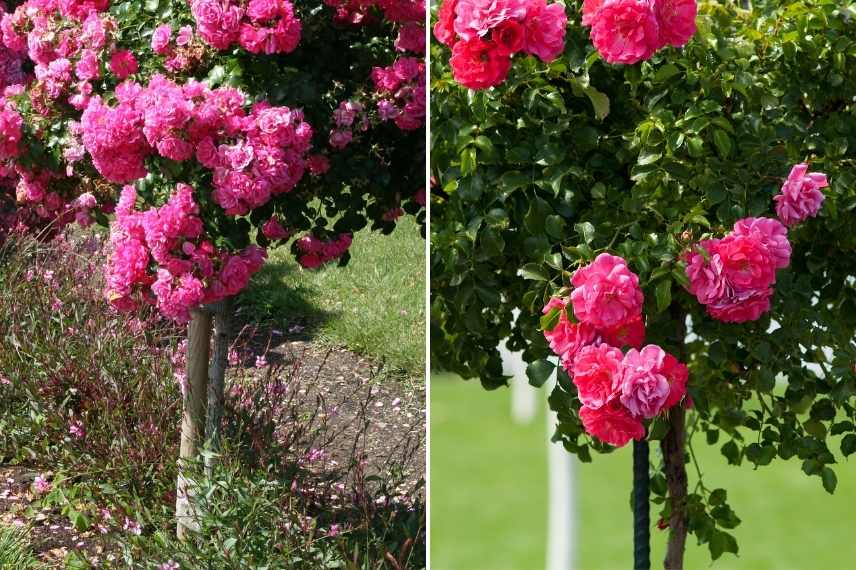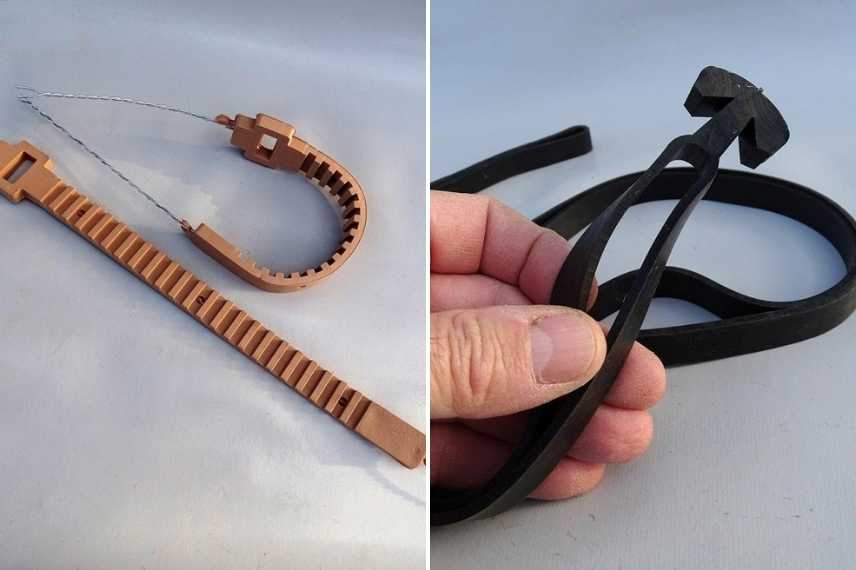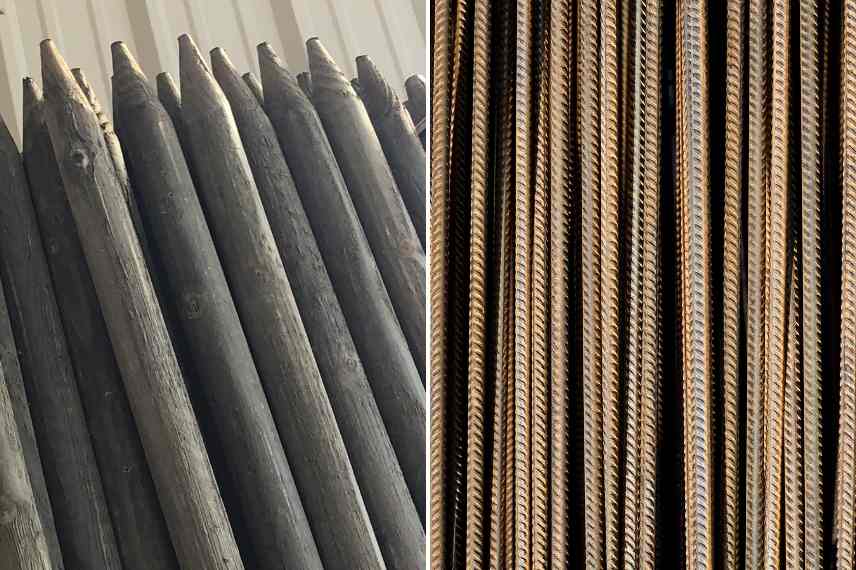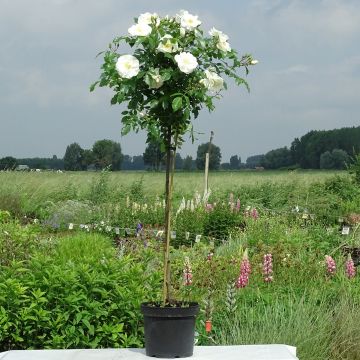
How to stake standard and weeping roses?
Our tips for effective and attractive staking
Summary
Standard and weeping roses, grown on a high stem of at least 1 m, require solid staking to support their trunk, dense branches and to display their abundant summer flowering. Indeed, these flower heads catch more wind than those of classic roses, because their trunk remains fragile and the weight of the inflorescences is considerable at the height of summer. Preserving, and more specifically showcasing the trailing habit of weeping roses, is the other role played by a stake adapted to these forms. Which types of stake should you choose? How and when should you install their supports? What type of tie should you use? We explain everything in this advice sheet!

Standard roses are inseparable from their stake
Which model of plant support?
Achieving good mass and volume is essential for a weeping rose. A standard rose also needs sufficient support to develop its attractive sphere of roses. For both rose types, what matters are the strength, long lifespan and appearance of stakes, because they will support the plant in the long term!
Staking for high-trained roses therefore needs to be very rigid. It is the true anchorage of the rose in the ground while roots develop. Although shape differs between standard and weeping roses, ideally stakes should be steel or other metal. You can, however, use a wood stake for standard roses.
Parasol stakes, also called umbrella stakes, used specifically for weeping roses: in steel, they have a characteristic umbrella shape to splay branches and guide them — the result is a dome from which the rose’s weeping branches will spill down (weeping roses are grafted onto climbing varieties, which are particularly flexible and trailing).
Standard rose
Top of stake should reach graft point, so allow minimum 1.10 m for a half-standard rose and 1.30 m for a standard rose. Stake generally remains in place for life on a standard rose, as main stem of such a rose does not increase significantly in diameter.
If you choose wood, minimum diameter should be 5 cm, chestnut wood or a rot-resistant wood species (never use treated wood that could contaminate soil).
You can also, although a little less aesthetic because more visible, install a tripod-style stake using three thinner wood stakes placed around the main stem. This system suits the tallest standard roses.

Wood and metal stake on standard rose
Weeping rose
Weeping roses require, because of their distinctive dome shape, a highly customised support! They are installed to remain immobile, since once branches are developed they become one with the support, and enhance the parasol effect and the rose’s trailing habit. These parasol stakes have the shape of a miniature umbrella. Branches are trained on the upper parasol portion, guided harmoniously to all sides of the structure. They come in different heights, most commonly 2.50 m.
You may also read
What is a standard rose or a weeping rose?How to proceed?
To avoid damaging roots, it is always advisable to install a stake in the planting hole before placing a bush. This applies of course to both your standard rose and your weeping rose, especially as these have prominent branches: installing the stake before positioning them in the planting hole prevents any inadvertent injury you might cause. Carrying out this operation with two people will make the task easier :
- Dig your planting hole to a depth of 40-50 cm ;
- Install your stake by placing it vertically ;
- Position your rose, also vertically, about 10 cm from the stake: from an aesthetic point of view it is appealing to visually align the stake and the stem-trunk, but a minimum of space is essential for stem development. The stake should reach the graft union.
- Backfill the hole with garden soil enriched with potting compost if heavy, or amended with compost, then spread an organic rose fertiliser; firm the soil around the base of the stem and the stake, then water generously; for a weeping rose, start guiding the branches by tying them with a few soft ties to the dome-shaped metal support ;
- Attach the tie : this step is important, as the tie is essential to secure the rose to its stake without injuring it and while leaving room for future trunk development. The tie should be strong, made of flexible material, and, if possible, discreet. Keep tie in place without compressing the stem-trunk.
⇒ Find in our dedicated guide our detailed advice for planting standard and weeping roses.
Discover other Tree Roses - Stem Roses
View All →Available in 2 sizes
Available in 3 sizes
Available in 2 sizes
Available in 4 sizes
Available in 2 sizes
Available in 2 sizes
Available in 2 sizes
Attachment system
For standard and weeping roses, take particular care with the fixing tie between the vertical stake and the rose trunk so as not to cause any injury, as well as with the smaller ties that guide the branches of the weeping rose.
Flexible rubber ties (Serflex type) should be chosen for fastening around the trunk to allow it to grow without being damaged. You can also fit tree collars that have notches allowing the tie to be adjusted to the correct size of your stem and changed later. Finally, more rigid collars can be fitted a few months after planting.

⇒ Discover all our ties and attachment systems
You may also read
Protection of standard and weeping roses in winterPlant support: bought or DIY?
Weeping roses require an ultra-strong support of a very specific shape, so it is preferable to buy one commercially unless very handy. It will always be a metal support to carry the abundant flowering borne on long trailing stems. This parasol-shaped support allows stems to form a dome when trained onto it, producing a very harmonious trailing habit. This support can be left in place for life once installed. You can install it after planting, but the operation is much more delicate and may damage the root system.
For standard roses, you have a little more choice :
- If you have wooden stakes of large diameter (about 5 cm) and the desired height, made of chestnut, hazel or acacia, you can use them; they will be strong enough provided they are perfectly straight. Make sure to disinfect them thoroughly if previously used; they must be free from any parasitic contamination.
- You can also make a steel stake from reinforcing bar with a minimum diameter of 12 mm, which has the advantage of being extremely strong, inexpensive, and quickly developing an attractive, discreet rusty colour as it oxidises. In addition, the twisted finish of the rod helps to hold the tie securely.
- For ease, many metal stakes are available commercially; key for a standard rose is choosing the correct stake height, remembering it should reach the graft union.

Wood stakes of sufficient diameter make good supports for standard roses, as does reinforcing bar cut to size
- Subscribe!
- Contents
![[Tutoring-roses-stems-and-weepers]](https://www.promessedefleurs.ie/blogwp/wp-content/uploads/2021/01/Tuteurer-rosiers-tiges-et-pleureurs.jpg)









































Feedbacks